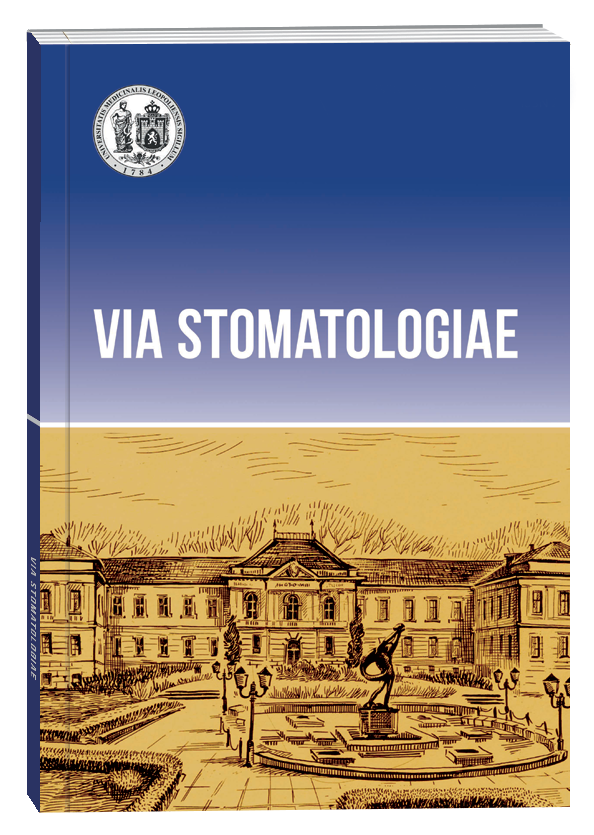DYNAMICS OF THE STRUCTURE OF MALOCCLUSUION IN SCHOOLCHILDREN
DOI:
https://doi.org/10.32782/3041-1394.2024-3.5Keywords:
children, malocclusion, prevalenceAbstract
Introduction. Malocclusion are among the main dental diseases and, according to many researchers, rank third place in prevalence after dental caries and periodontal tissue pathology. Modern scientific research shows that malocclusion are diagnosed in the majority of the Ukrainian pediatric population, with a prevalence rate of 57,5– 87,3%. The monitoring of dental morbidity among children in Ukraine in different regions shows a significant increase in the prevalence of malocclusion in recent years. It is important to take into account that malocclusion and dysfunctions of the dentoalveolar system not only affect the child’s health, but also have a significant impact on the personality and social status of the younger generation. This emphasises the importance of timely diagnosis and prevention of these pathologies, and the need to use modern and effective treatment methods. Thus, the problem of providing orthodontic care to children and adolescents is relevant today and has important medical and social significance. The aim of the study. To assess the dynamics of the prevalence and structure of dentoalveolar anomalies in children aged 6–16 years to optimise the organisation and provision of orthodontic care. Research materials and methods. A total of 1167 children aged 6–16 years in Lviv were examined to study the prevalence and structure of malocclusion. All children were divided into three age groups depending on the period of occlusion formation. The classification of D.A. Kalvelis was used to verify the diagnosis. Determination of a significant difference in the parameters compared was performed using Student’s t-test. Results. Tendencies to increase in the prevalence of malocclusion in the age aspect have been identified, which may be due to various factors, in particular, in the period from 6 to 8 years – untimely detection of risk factors and lack of measures to eliminate them. Conclusions. 1. On average, 63,67 ± 1,41% of the examined children were diagnosed with malocclusion, which indicates a low level of treatment and preventive and public health education work. With age, the prevalence of orthodontic pathology increases from 57,11 ± 2,43% in 6–9 years old children to 66,23 ± 2,71% in 10–12 years old, and in permanent dentition in 13–16 years olds its value increases to 68,01 ± 2,21%. 2. Among all malocclusion, anomalies of dental arches are the most common – 64,87 ± 1,75%, malocclusion of occlusion are diagnosed in 51,28 ± 1,83% of cases, and individual tooth anomalies are found in only 8,61 ± 1,03% of the examined. 3.A decrease in the number of children with malocclusion from 6 to 16 years from 76,74 ± 6,44 to 34,15 ± 5,24% indicates the presence of pronounced self-regulation processes and, possibly, timely and qualified orthodontic treatment in the past.
References
Дорошенко С. І., Савонік С. М. Поширеність зубощелепних аномалій у дітей віком 4–17-ти років. Сучасна стоматологія. 2020. № 5. С. 70–72.
Розповсюдженість зубощелепних деформацій і захворювань тканин пародонта в дорослих у різні вікові періоди / М.С. Дрогомирецька та ін. Український стоматологічний альманах. 2010. № 2. С. 51–57.
Поширеність зубощелепних аномалій та мовленнєвих порушень серед дітей віком 6–12 років / П.С. Фліс та ін. Сучасна стоматологія. 2018. № 4. С. 54–57.
Поширеність та структура зубощелепних аномалій у дітей забруднених територій екосистеми Верхнього Полісся / А.М. Потапчук та ін. Сучасна стоматологія. 2019. № 2. С. 50–55.
Порівняльна характеристика морфо-фунціонального стану зубощелепної ділянки в пацієнтів у період раннього та пізнього змінного прикусу / Л.В. Смаглюк та ін. Вісник проблем біології і медицини. 2016. Вип. 1. Т. 2. С. 267–270.
Епідеміологічні дослідження та моніторинг стоматологічної захворюваності у дітей України / А.О. Янчук та ін. Світ медицини та біології. 2019. № 2. С. 154–158.
Частота та структура ортодонтичної патології в дітей з регіону з підвищеним вмістом фтору в питній воді / Е.В. Безвушко та ін. Вісник стоматології. 2012. № 1. С. 66–68.
Безвушко Е.В., Міськів А.Л. Динаміка поширеності зубощелепних аномалій у дітей Львівської області. Вісник проблем біології і медицини. 2015. Вип. 2. Т. 2. С. 21–24.
Поширеність карієсу зубів у дітей 9–12 років Томашпільського району Вінницької області / О.С. Васильчук та ін. Вісник морфології. 2016. Т. 1. № 1. С. 155–158.
Rashid A., Feky H.E. Prevalence of malocclusion using Angle classification within dental students of Fayoum University. Egypt. Egyptian Dent. J. 2019. Vol. 65. № 2. P. 965–969.
Aikins E.A., Onyeaso C.O. Prevalence of malocclusions and occlusal traits among adolescents and young adults in River State, Nigeria. Odontostomatol. Trop. 2014. Vol. 37. № 145. P. 5–12.
Edith M. Prevalence of malocclusion among schoolchildren in Mombasa Country, Kenya. Scien. Arch. Dent. Sci. 2019. Vol. 2. № 12. P. 57–63.
Impact of malocclusion on the Oral Health-Related Quality of Life of early adolescents in Ndola, Zambia / N.A. Severine et al. Int. J. Dent. [Internet]. 2018. Vol. 2018. P. Article ID 7920973. http://doi.org/10.1155/2018/7920973.
Asiry M.A., Alshahrani I. Prevalence of malocclusion among schoolchildren of Southern Saudi Arabia. J. Orthod. Sci. 2019. Vol. 8. P. 2. http://doi: 10.4103/jos.JOS_83_18.
Prevalence of malocclusion in Saudi Arabia Children : a literature review / A.I. Amer et al. EC Dent. Sci. 2020. Vol. 19. № 1. P. 1–6.
Prevalence of malocclusion and its association with delirious oral habits in Saudi schoolchildren / A.H. Alanazi et al. Egyptian J. Hospital Med. 2018. Vol. 71. № 6. P. 3290–3294.
Гельсінська декларація Всесвітньої медичної асоціації. Морфологія. 2010. Т. 4. № 2. С. 65–68.
Методичні рекомендації по статистичній обробці / Н.І. Смоляр та ін. Львів, 1995. 17 с.







